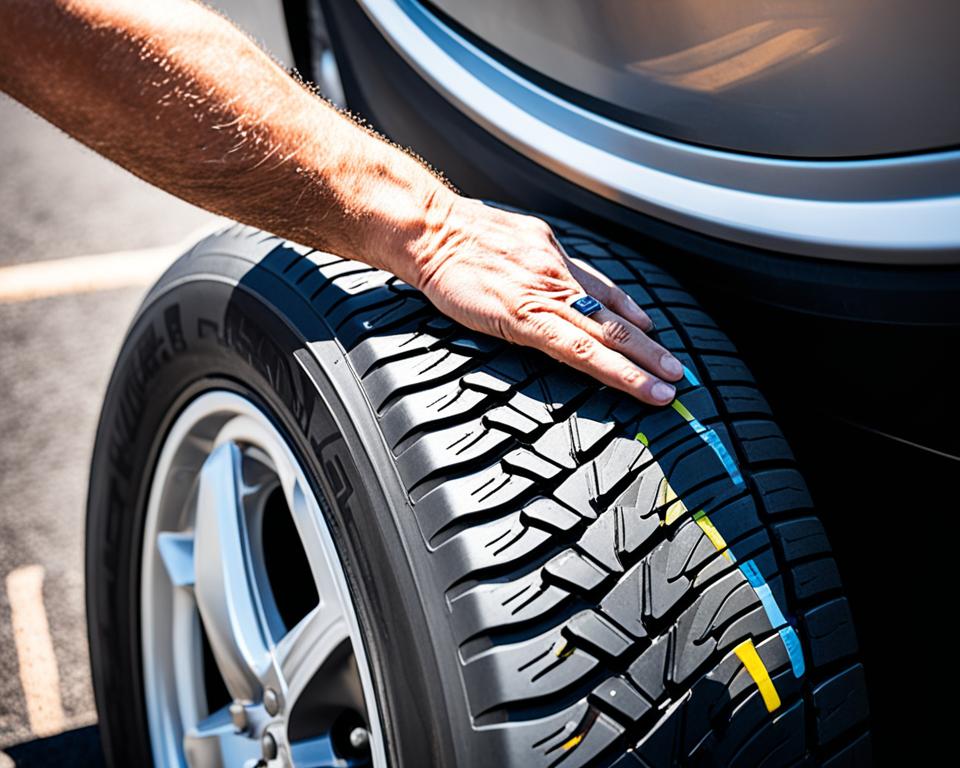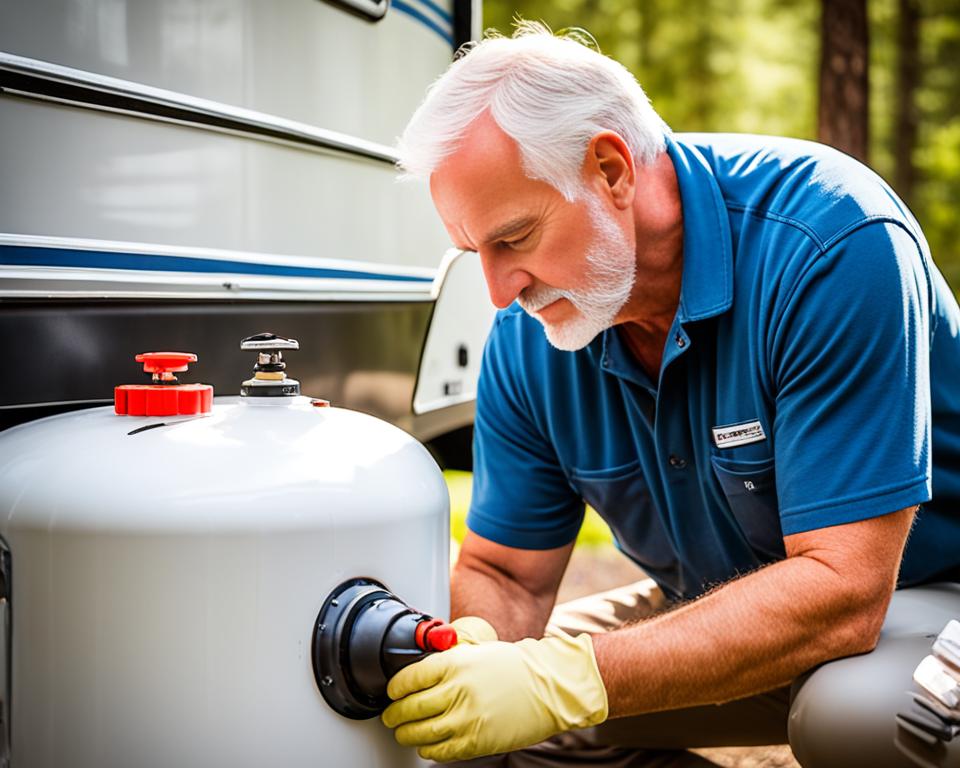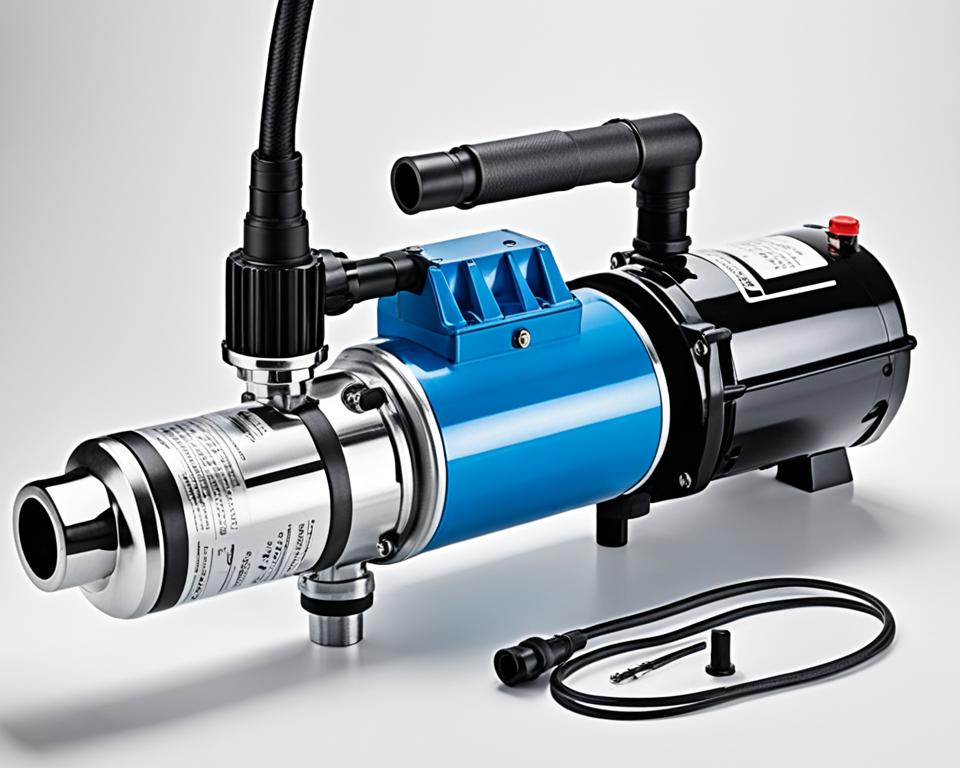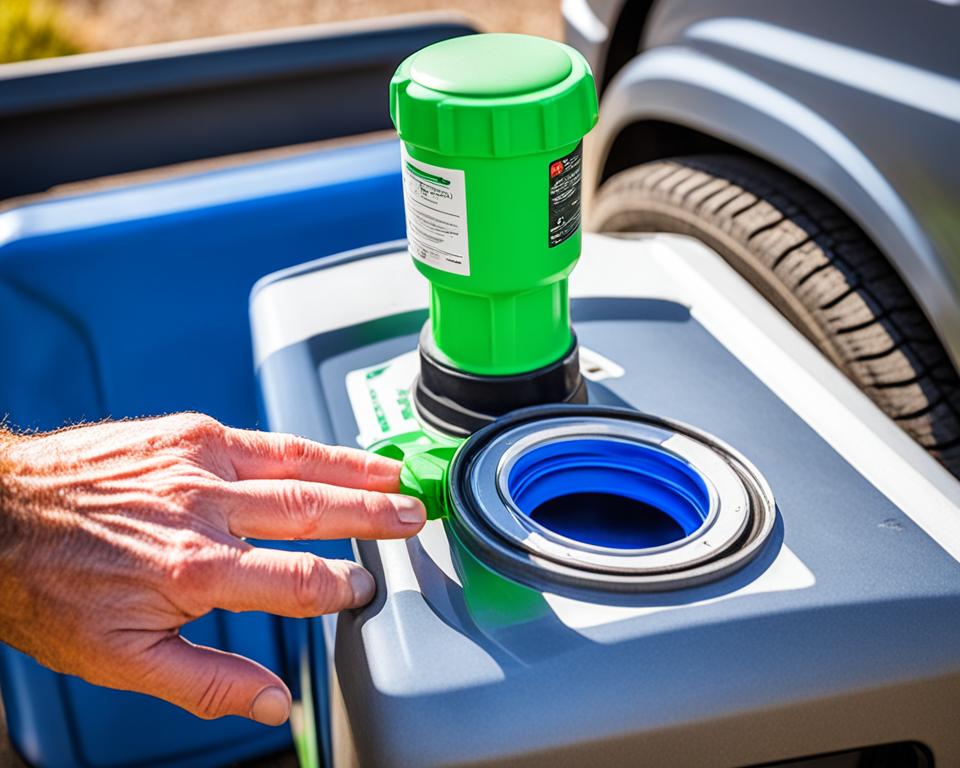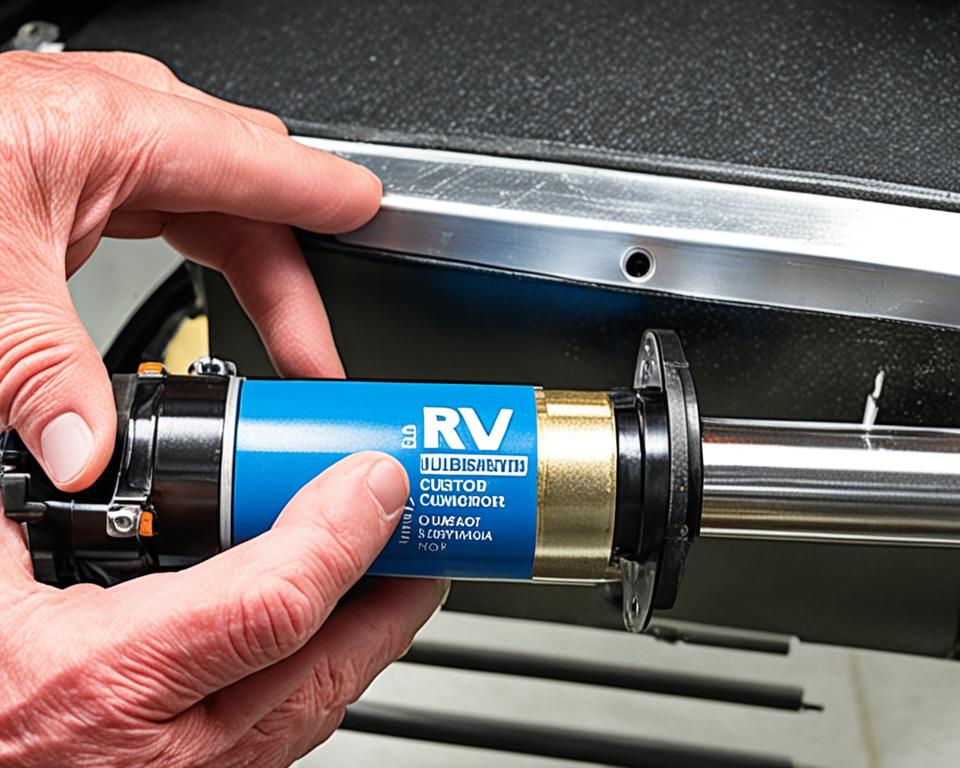Tires are an essential part of your RV, providing mobility and support. Neglecting tire care can lead to excessive wear and safety concerns. One crucial aspect is maintaining proper air pressure, as it determines the load capacity of the tire. RV tires can degrade over time due to age, exposure to UV rays, and lack of use. Checking the DOT number on your tires can help determine their age. Proper care includes keeping tires clean and dry, using tire dressings without harmful ingredients, using tire covers to protect against UV rays, and driving your RV regularly to prevent tire hardening and flat spots.
Key Takeaways:
- Regularly check tire pressure to ensure proper air pressure and load capacity
- Monitor tire tread depth and replace tires when tread falls below a safe level
- Protect tires from UV rays and ozone to prevent sidewall cracking and degradation
- Inspect tires regularly for signs of wear, damage, or unusual bulges
- Proper tire care and maintenance are vital for safety and peace of mind during RV travels
Understanding Tire Pressure and Load Capacity
The air pressure inside the tire is crucial for supporting the vehicle and ensuring optimal performance. It directly affects the load capacity of RV tires, which is determined by the contact patch – the area of the tire that comes in contact with the road surface. To maintain tire safety and prevent premature wear, it’s essential to understand the importance of proper tire pressure and load capacity.
Tire Pressure and Safety
Both underinflated and overinflated RV tires pose safety risks and can affect your overall driving experience. Underinflation can lead to increased rolling resistance, decreased fuel efficiency, and uneven tire wear. On the other hand, overinflated tires can result in a harsher ride and an increased risk of tire failure.
To ensure the safety of your RV and its occupants, it’s important to check the tire pressure regularly, especially before embarking on a trip. The recommended PSI (pounds per square inch) for optimal tire performance can usually be found on the RV manufacturer’s data plate or the chassis manufacturer data sticker. If you’re unsure about the recommended PSI for your specific model, consult the owner’s manual or reach out to the manufacturer.
Tire Load Capacity
Load capacity refers to the maximum weight a tire can safely support when inflated to the recommended PSI. Exceeding the load capacity can cause the tire to overheat and potentially fail, leading to accidents or damage to your RV.
Understanding the load capacity of your RV tires is crucial in preventing overloading and maintaining safe driving conditions. You can find the load capacity information on the tire’s sidewall, usually marked as the maximum load rating, and it’s important not to exceed this limit.
The Relationship Between Tire Pressure and Load Capacity
Proper tire pressure is directly related to load capacity. Underinflated tires have reduced load capacity, while overinflated tires may have increased load capacity but compromised safety and performance. Maintaining the recommended tire pressure ensures optimal load capacity, which is necessary for safe and efficient RV travel.
Regularly inspecting and maintaining the correct tire pressure, as recommended by the manufacturer, helps prevent safety issues and premature tire wear. By keeping your RV tires properly inflated, you’ll not only enhance driving comfort but also extend the lifespan of your tires.
To visualize the relationship between tire pressure and load capacity, refer to the table below:
| Tire Pressure (PSI) | Load Capacity (lbs) |
|---|---|
| 40 | 2,000 |
| 50 | 2,500 |
| 60 | 3,000 |
| 70 | 3,500 |
Remember, maintaining proper tire pressure and load capacity is imperative for a safe and enjoyable RV journey. By taking the time to regularly check and adjust tire pressure, you’ll ensure the longevity and optimal performance of your RV tires.
Factors Affecting RV Tire Lifespan
RV tires are designed to last up to 10 years, but they are often replaced sooner due to aging and wear. Several factors can influence the lifespan of these tires, including weather conditions, storage practices, inflation pressure, driving speed, exposure to ozone, and maintenance routines.
One of the primary factors affecting tire lifespan is exposure to the elements. RV tires are constantly exposed to varying weather conditions, including temperature changes, rain, and sunlight. Extended periods of parking and exposure to UV rays can accelerate tire aging, leading to sidewall cracking and dryness.
“Regular inspections, proper inflation, tire protection, and maintenance practices are essential for ensuring the safety and longevity of your RV tires.”
In addition to environmental factors, maintenance practices play a crucial role in maximizing the lifespan of RV tires. It is recommended to inspect the age of your tires by checking the DOT number, which provides information on the manufacturing date. Annual inspections are especially important after the first five years of tire use.
By following proper tire care and maintenance routines, you can effectively prolong the lifespan of your RV tires and maintain optimal safety on the road.
Factors Affecting RV Tire Lifespan:
- Weather conditions
- Storage practices
- Inflation pressure
- Driving speed
- Exposure to ozone
- Maintenance routines
Table: Common factors affecting RV tire lifespan
| Factor | Impact on Tire Lifespan |
|---|---|
| Weather conditions | Extreme temperatures, rain, and sunlight can accelerate tire aging. |
| Storage practices | Prolonged parking without proper care can lead to tire degradation. |
| Inflation pressure | Underinflation or overinflation can result in premature wear and reduced tire lifespan. |
| Driving speed | Excessive speed can generate heat and friction, causing tire damage and reducing lifespan. |
| Exposure to ozone | Ozone can lead to deterioration and cracking of tire sidewalls, reducing lifespan. |
| Maintenance routines | Regular inspections, proper inflation, and timely repairs contribute to prolonged tire lifespan. |
“Taking care of your RV tires by following proper maintenance routines can help ensure optimal safety and a longer lifespan for your tires.”
Essential RV Tire Care and Maintenance Tips
Proper care and maintenance of RV tires are vital to ensure safe and enjoyable travels. Regular inspections are crucial for identifying signs of wear, damage, or unusual bulges that can lead to tire failure on the road. Monitoring tire tread depth is equally important as it directly affects traction and grip. Sidewall cracks or dryness can also indicate potential issues that require attention.
Here are some essential RV tire care tips:
- Regular Inspections: Perform visual inspections of your RV tires, checking for signs of wear, damage, or bulges. Pay close attention to the tread and sidewalls.
- Tire Tread Depth: Monitor the tread depth of your RV tires. The minimum legal tread depth is typically 2/32 of an inch, but it’s recommended to replace tires when the tread depth falls below 4/32 of an inch for enhanced safety.
- Sidewall Inspection: Examine the sidewalls for any cracks, cuts, or dryness. These can weaken the tire structure and increase the risk of blowouts.
- Tire Rotation: Regularly rotate your RV tires to ensure even wear. This practice helps extend the lifespan of the tires and promotes better performance.
- Address Damage Promptly: If you discover any damage during your inspections, such as punctures or cuts, it’s vital to address them promptly. Depending on the severity, the tire may need to be repaired or replaced.
By following these essential RV tire care and maintenance tips, you can help ensure the safety and longevity of your tires, providing peace of mind during your travels.

“Regular inspections and maintenance are essential for the safety and longevity of your RV tires.” – Tire Care Expert
Protecting RV Tires from UV Rays and Environmental Factors
UV rays and ozone can have damaging effects on RV tires, leading to sidewall cracking and degradation. It’s important to take proactive measures to protect your RV tires from these environmental factors to ensure their longevity and safety. Here are some key tips to safeguard your tires:
1. Using RV Tire Covers
When your RV is parked for extended periods, using RV tire covers can provide effective protection against UV rays. These covers act as a barrier, shielding the tires from direct sunlight and preventing UV damage. Choose covers specifically designed for RV tires that offer high-quality UV protection.
2. Avoiding Ozone Exposure
Ozone, a harmful gas present in the atmosphere, can accelerate tire degradation. Avoid parking your RV in areas with high electrical use or where welding is being done, as these activities release ozone. By staying away from ozone sources, you can minimize the risk of sidewall cracking and other tire damage.
3. Choosing the Right Tire Dressing or Protectant
Applying a proper tire dressing or protectant can help prevent drying and cracking of the tire sidewalls. Look for products specifically formulated for RV tires and avoid ones that contain harmful ingredients. These dressings nourish the rubber, keeping it supple and resistant to UV rays.
By implementing these preventive measures, you can protect your RV tires from the harmful effects of UV rays and environmental factors. This will help extend their lifespan, ensuring optimal performance and safety during your RV adventures.
| Benefits of RV Tire Protection | Effective Measures for Tire Protection |
|---|---|
| 1. Prevents sidewall cracking | 1. Use RV tire covers |
| 2. Minimizes tire degradation | 2. Avoid ozone exposure |
| 3. Increases tire lifespan | 3. Choose the right tire dressing or protectant |
The Importance of Proper RV Tire Inflation
Proper tire inflation is vital for maintaining the longevity and performance of your RV tires. Failing to maintain the correct tire pressure can have significant consequences on both safety and overall tire health. Let’s explore why maintaining proper tire inflation is crucial for your RV.
The Risks of Underinflated Tires
Underinflated tires can cause a range of problems that compromise the safety and performance of your RV. When tires are underinflated, they create increased rolling resistance, which leads to decreased fuel efficiency. This not only results in higher fuel consumption but also increases the overall cost of your travels. Furthermore, underinflated tires are more prone to uneven wear, reducing their lifespan and requiring more frequent replacements.
The Dangers of Overinflated Tires
On the other hand, overinflated tires can be just as dangerous. When tires are overinflated, they become rigid and less able to absorb shocks from the road. This can result in a harsher ride, potentially causing discomfort for you and your passengers. Moreover, overinflation significantly increases the risk of tire failure, as it puts excessive strain on the tire structure, making it more susceptible to blowouts or punctures.
The Importance of Regular Inspections
To ensure proper tire inflation, it’s crucial to regularly check the tire pressure and maintain it at the recommended level. The manufacturer’s recommendations for tire pressure can usually be found in the RV owner’s manual or on a sticker inside the vehicle. By diligently monitoring and adjusting tire pressure as needed, you can mitigate the risks associated with underinflation and overinflation, promoting safer travels and extending the life of your RV tires.
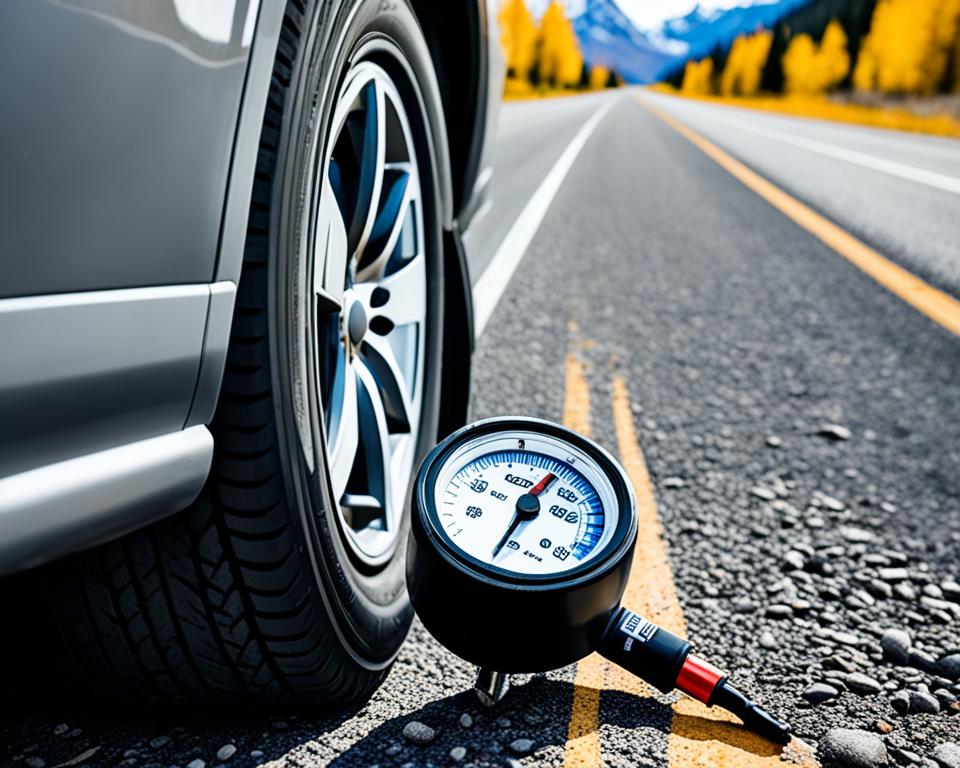
Summary
Proper tire inflation is a fundamental aspect of RV tire care. Underinflated tires can lead to decreased fuel efficiency and uneven wear, while overinflated tires can result in a harsh ride and increased risk of failure. Regularly checking and maintaining the correct tire pressure recommended by the manufacturer ensures optimal tire performance and safety on the road.
Common RV Tire Maintenance Mistakes to Avoid
Avoid these common RV tire maintenance mistakes to ensure optimal tire safety and longevity. Neglecting tire inspections and maintenance, such as not checking tire pressure regularly or overlooking signs of wear, can lead to safety concerns and costly repairs. Using the wrong tire dressing or protectant that contains harmful ingredients can accelerate tire degradation. Storing your RV for long periods without proper tire care and maintenance can result in tire hardening, flat spots, and reduced lifespan.
The Importance of RV Tire Care for Safety and Peace of Mind
Taking care of your RV tires is not only essential for safety but also for peace of mind. Proper tire care and maintenance help prevent accidents caused by tire failure, ensure optimal tire performance, and extend tire lifespan.
Regular inspections play a crucial role in identifying any signs of wear, damage, or unusual bulges that may indicate tire problems. By inspecting your RV tires regularly, you can address any issues promptly and avoid potential hazards on the road.
In addition to inspections, maintaining proper tire inflation is vital to ensure the safety and longevity of your RV tires. Underinflated tires can lead to increased rolling resistance, decreased fuel efficiency, and uneven wear. On the other hand, overinflated tires can result in a harsh ride and an increased risk of tire failure. By regularly checking and maintaining the correct tire pressure as recommended by the manufacturer, you can optimize your tire’s performance and enhance your safety on the road.
Monitoring tread depth
Monitoring the tread depth of your RV tires is another essential aspect of tire care. Tread depth plays a crucial role in providing traction and handling on different road surfaces. As the tire tread wears down over time, it becomes less effective at channeling water away from the tire, increasing the risk of hydroplaning.
To ensure safe driving conditions, it’s important to monitor the tread depth regularly. Many RV tires have built-in indicators known as “wear bars” that indicate when the tread is worn to the recommended depth. If the tread depth falls below this level, it’s time to replace the tire to maintain optimal safety.
Protecting tires from UV rays and environmental factors
RV tires are exposed to various environmental factors that can accelerate their aging process. UV rays, in particular, can cause sidewall cracking and degradation over time. Additionally, exposure to ozone and extreme weather conditions can also impact tire integrity.
One effective way to protect your RV tires from UV rays is by using tire covers. Tire covers provide a physical barrier that blocks UV rays and prevents direct exposure to sunlight. Additionally, parking your RV in shaded areas or using an RV cover can also help minimize the damage caused by UV rays and other environmental factors.
It’s also important to choose a proper tire dressing or protectant that does not contain harmful ingredients. Some tire dressings or protectants may cause tire drying and cracking, which can compromise tire safety. Selecting a high-quality product designed specifically for RV tires will help maintain their integrity and extend their lifespan.
Enjoying worry-free RV travel
By prioritizing RV tire care and maintenance, you can enjoy worry-free travels on the road. Regular inspections, proper inflation, monitoring tread depth, and protecting tires from UV rays and environmental factors are crucial steps to maintain tire safety.
Properly cared for tires ensure optimal performance, improved fuel efficiency, and reduced risk of accidents. With well-maintained tires, you can have peace of mind knowing that your RV is equipped with reliable tires that can withstand the demands of the road.
Remember, investing time and effort into tire care today will pay off in terms of safety and long-term cost savings. By following recommended tire care practices, you can embark on your RV adventures with confidence, knowing that your tires are in excellent condition.
| Benefits of Proper RV Tire Care |
|---|
| Improved safety |
| Extended tire lifespan |
| Optimal tire performance |
| Enhanced fuel efficiency |
| Reduced risk of tire failure |
| Peace of mind during RV travels |
Conclusion
Maintaining and caring for your RV tires is a vital aspect of RV ownership. By following the DIY RV Tire Care Guide and implementing regular inspections, proper inflation, tire protection, and maintenance practices, you can ensure the safety and longevity of your RV tires.
Key takeaways from the DIY RV Tire Care Guide include:
- Regularly inspecting your RV tires for signs of wear, damage, and unusual bulges
- Maintaining proper air pressure to ensure optimal load capacity and tire performance
- Protecting your RV tires from UV rays and environmental factors by using tire covers and choosing the right tire dressing or protectant
- Taking prompt action to repair or replace damaged tires
- Rotating your tires regularly to promote even wear
Taking these steps will provide peace of mind and enable you to enjoy worry-free travels on the road. Remember to prioritize tire safety and make tire care an integral part of your RV maintenance routine.
FAQ
What are the essential aspects of DIY RV tire care?
DIY RV tire care involves maintaining proper air pressure, regular inspections for wear and damage, monitoring tread depth, rotating tires, and protecting them from UV rays and environmental factors.
How important is tire pressure for RVs?
Tire pressure is crucial for load capacity and tire performance. Underinflated or overinflated tires can lead to safety issues and premature wear. Regularly checking and maintaining the correct tire pressure is essential.
How long do RV tires last?
RV tires can have a service life of up to 10 years, but they are typically replaced sooner due to aging and wear. Various factors such as weather conditions, storage conditions, inflation pressure, and maintenance practices can affect the lifespan of RV tires.
What should I inspect on my RV tires?
You should regularly inspect your RV tires for signs of wear, damage, or unusual bulges. Checking tire tread depth and sidewalls for cracks or dryness is crucial for safe driving. Address any damage promptly by repairing or replacing the tire.
How can I protect my RV tires from UV rays?
Using RV tire covers that block UV rays is an effective way to protect your tires when parked for extended periods. Avoid parking your RV near ozone sources, and choose a tire dressing or protectant without harmful ingredients to prevent sidewall cracking and degradation.
How important is proper tire inflation for RVs?
Proper inflation is crucial for the longevity and performance of RV tires. Underinflated tires can lead to increased rolling resistance and uneven wear, while overinflated tires can result in a harsh ride and increased risk of failure. Regularly checking and maintaining the correct tire pressure is essential.
What are common RV tire maintenance mistakes to avoid?
Avoid neglecting tire inspections and maintenance, using the wrong tire dressing or protectant, and storing your RV without proper tire care. Not checking tire pressure regularly and overlooking signs of wear can lead to safety concerns and costly repairs.
Why is RV tire care important for safety and peace of mind?
Proper RV tire care ensures tire safety, optimal performance, and an extended lifespan. By preventing accidents caused by tire failure and addressing maintenance needs, you can enjoy worry-free travels on the road.

